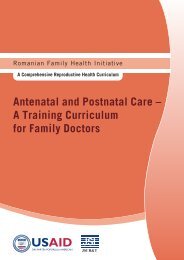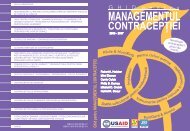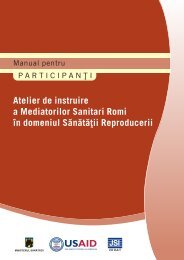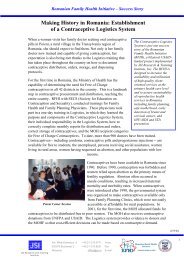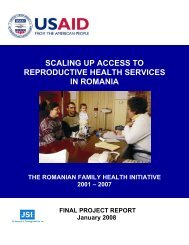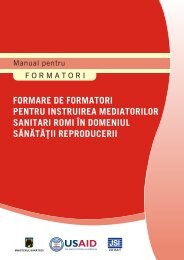Training of Roma Health Mediators in Reproductive Health
Training of Roma Health Mediators in Reproductive Health
Training of Roma Health Mediators in Reproductive Health
Create successful ePaper yourself
Turn your PDF publications into a flip-book with our unique Google optimized e-Paper software.
o <strong>Reproductive</strong> tract <strong>in</strong>fections are more common <strong>in</strong> women because <strong>of</strong> their<br />
body structure and functions (like menstruation, pregnancy and childbirth).<br />
They are much more vulnerable to the entry and growth <strong>of</strong> disease-germs.<br />
• Not all reproductive tract <strong>in</strong>fections are STIs.<br />
o There are many types <strong>of</strong> <strong>in</strong>fections and <strong>in</strong>flammations <strong>of</strong> the reproductive<br />
tract exhibit<strong>in</strong>g different symptoms <strong>in</strong> men and women.<br />
o They may be caused by different organisms/germs that enter the reproductive<br />
tract, or by organisms which normally live <strong>in</strong> the reproductive tract when<br />
these expand <strong>in</strong> numbers. The reproductive tract can get <strong>in</strong>fected by:<br />
• Poor general health due to poor diet, lack <strong>of</strong> sleep, and life stresses which<br />
lower the body’s resistance to <strong>in</strong>fection<br />
• Poor genital hygiene, which promotes <strong>in</strong>fections (unclean underwear,<br />
failure to change or remove pads, wip<strong>in</strong>g from rear to front after pass<strong>in</strong>g<br />
stools)<br />
• Use <strong>of</strong> some soaps, perfumes and deodorants which irritate tender sk<strong>in</strong><br />
• Some medic<strong>in</strong>es (antibiotics) that kill normal bacteria that protect the<br />
vag<strong>in</strong>a’s health<br />
• Sexual <strong>in</strong>tercourse with an <strong>in</strong>fected person<br />
• Trauma (e.g. from delivery, sexual <strong>in</strong>tercourse or use <strong>of</strong> chemicals, etc.)<br />
• Unhygienic practices <strong>of</strong> health-care providers (e.g. unhygienic delivery or<br />
abortion practices, <strong>in</strong>sertion <strong>of</strong> contam<strong>in</strong>ated IUD).<br />
• One cannot recognize a person hav<strong>in</strong>g a STI just by look<strong>in</strong>g at him/her as s/he<br />
may look normal<br />
o STIs may not produce any signs/symptoms, particularly <strong>in</strong> women<br />
o People hav<strong>in</strong>g a STI without symptoms may not know that they are <strong>in</strong>fected,<br />
and they act as carriers, or may spread the <strong>in</strong>fection to others.<br />
By <strong>in</strong>corporat<strong>in</strong>g STI prevention, early detection and referral messages <strong>in</strong>to all types<br />
<strong>of</strong> education, mediators can raise awareness and help community members to take<br />
responsibility to protect themselves from these types <strong>of</strong> <strong>in</strong>fections.<br />
II.<br />
REDUCING THE RISK OF STIs (30 m<strong>in</strong>utes)<br />
Suggest that we have just learned how STIs are transmitted and some <strong>of</strong> the symptoms <strong>of</strong><br />
STI <strong>in</strong>fection. Now we will discuss how people can reduce their risk <strong>of</strong> becom<strong>in</strong>g<br />
<strong>in</strong>fected with an STI or <strong>in</strong>fect<strong>in</strong>g others. Ask:<br />
‣ What should you do if you have symptoms or th<strong>in</strong>k you may have been <strong>in</strong>fected with<br />
an STI?<br />
• See a health provider.<br />
• Don’t have sex aga<strong>in</strong> until you are checked.<br />
• Follow the medical recommendation and treatment. Many STIs can be cured if the<br />
person is treated right away.<br />
• Remember that some STIs do not have symptoms. Yet, they can still make you very<br />
166<br />
RFHI/JSI <strong>Roma</strong>nia <strong>Tra<strong>in</strong><strong>in</strong>g</strong> <strong>of</strong> RHMs <strong>in</strong> <strong>Reproductive</strong> <strong>Health</strong> Session 10: STIs



